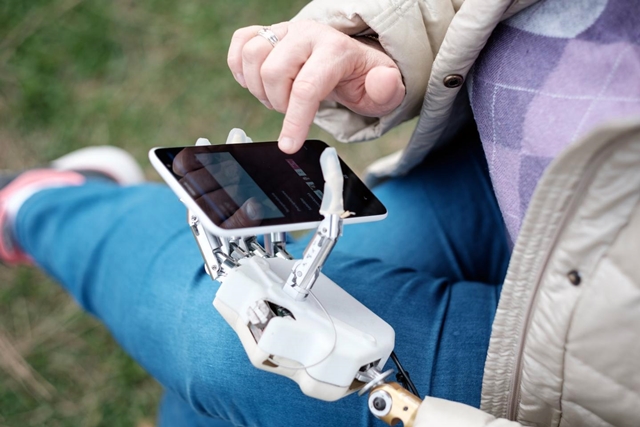22 Feb. 2019. An advance in prosthetics and robotics enables artificial hands to provide a more natural sense of position and reach in the dark or without looking at objects. Researchers from institutions in Switzerland and Italy describe this development in the 20 February issue of the journal Science Robotics.
A team from École Polytechnique Fédérale de Lausanne, or EPFL, in Switzerland, Scuola Superiore Sant’Anna in Pisa, Italy, and Fondazione Policlinico Agostino Gemelli in Rome is seeking to provide people with prosthetic hands and arms a better sense of the position of their limbs at any point in time, including while moving and in the dark, a sensory condition known as proprioception. This condition gives an individual a better sense of equilibrium and balance, and helps the person better understand a target object’s shape, position, and size, functions taken for granted in people with fully working hands.
Researchers from the Translational Neural Engineering lab at EPFL led by biomedical engineering professor Silvestro Micera study implantable neural interfaces and robotic systems to sensory and motor functions in people with disabilities from spinal cord injuries, stroke, or amputations. Micera, also on the faculty at Sant’Anna School of Advanced Studies in Pisa, and colleagues are building on advances in prosthetics that now provide more voluntary motor control of artificial limbs and better tactile feedback than before. Some 5 years ago, Science & Enterprise reported on one of these advances by Micera, to provide a sensory feedback system for an amputee’s prosthetic hand to control grasping and sense stiffness and shapes of objects.
In the new study, the team designed a prosthetic hand with more electrical stimulation of nerves in the remaining forearm stump. The researchers tested the device with two participants, both amputees, who received training to translate and interpret the electrical signals from the system. The participants were asked to detect passive motion of the prosthetic hand, where the researchers moved the device without participants seeing the movements, and indicate when they could sense the change in position.
The results show one participant noticed movements after a 6.5 degree change, while the other participant noticed movements after 12.5 degrees on average. The researchers found no statistically reliable correlation between the initial position of the hand and movement direction, indicating proprioceptive sensibility by participants was independent of movement’s direction.
The team also conducted joint angle reproduction tests, which asked participants to move the hands and fingers to specified positions. The tests first asked participants to move the hands to 4 self-selected angles, then to open and close the fingers on the hand to previous positions passively set by researchers. The median deviation on the first set of tests ranged from 4 to 10 degrees between the two participants, and 9 to 10 degrees on the second set.
In addition, participants were asked to estimate the diameter of cylinders by feeling the objects with their prosthetic hands. The participants estimated the objects’ diameters correctly in 78 percent of cases, compared to 99 percent for a comparison group of healthy volunteers. In a more demanding task, participants were asked to estimate the size and shape of 4 objects, which they achieved correctly 76 percent of the time, compared to 100 percent for healthy volunteers.
“Our study shows that sensory substitution based on intraneural stimulation can deliver both position feedback and tactile feedback simultaneously and in real time,” says Micera in an EPFL statement. “The brain has no problem combining this information, and patients can process both types in real time with excellent results.”
Micera, with co-authors Francesco Petrini and Stanisa Raspopovic, founded the company SensArs Neuroprosthetics in Lausanne, developing prosthetic devices for people with nerve damage. Co-authors Marco Controzzi is a founder and Christian Cipriani a stockholder of Prensilia, a company in Pontedera, Italy developing prosthetic hands.
More from Science & Enterprise:
- Report – U.S. Lags in Robotic Adoption
- Robotic Exoskeleton Systems Studied for Industrial Workforce
- Brain-Controlled Home Rehab for Stroke in Development
- Exosuit Designed for Personalized Walking Help
- Ultra-Sensitive Nanotech Robot Skin Receives Patent
* * *


 RSS - Posts
RSS - Posts
[…] Prosthetic Hand Gives Better Sense of Position, Movement […]